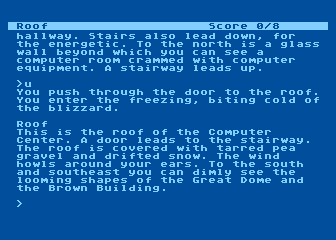Retro Replay Review
Gameplay
The Lurking Horror offers a classic text‐adventure experience powered by Infocom’s robust Z-machine engine. Players type commands to move through the chilly corridors of G.U.E. Tech, examining objects, solving environmental puzzles, and interacting with the few survivors who remain in the storm-bound complex. The parser accepts a variety of verbs—GET LAMP, EXAMINE DOOR, USE KEY—so you’ll feel immersed in a hands-on detective story as you uncover clues piece by piece.
(HEY YOU!! We hope you enjoy! We try not to run ads. So basically, this is a very expensive hobby running this site. Please consider joining us for updates, forums, and more. Network w/ us to make some cash or friends while retro gaming, and you can win some free retro games for posting. Okay, carry on 👍)
Puzzle design is both challenging and atmospheric. Early on, you’re focused on recovering your overwritten grad paper, which serves as a handy tutorial in basic exploration and object manipulation. But the obstacles quickly escalate: locked doors, hidden passageways, and supernatural barriers force you to think laterally. Many solutions hinge on combining unlikely items—putting together a hacksaw blade and a makeshift handle, for instance—so meticulous note-taking and map drawing are practically essential.
Combat scenarios are rare but tense. You’ll occasionally encounter rat‐like creatures or spectral entities that eye you as the perfect snack. Direct engagement often ends badly, so the game encourages cunning rather than brute force. Fending off foes with improvised weapons, or simply slipping past unseen, heightens the sense of vulnerability. Every wrong move can strand you in a locked room or provoke a monster, making each command prompt a moment of genuine suspense.
Graphics
Strictly speaking, The Lurking Horror features no traditional graphics—it’s a pure text adventure, after all. Instead, it relies on descriptive prose to paint vivid environments in the player’s mind. Each room is meticulously detailed: pipes groan with frost, the flickering glow of a dying light bulb casts monstrous shadows, and the faint drip of water echoes down the halls. This sensory language creates an atmosphere that can feel more haunting than any polygonal model.
Infocom’s text block presentation is clean and uncluttered on modern interpreters, and some editions include occasional location illustrations or a hand‐drawn map to guide newcomers. If you’re playing on a retro emulator or a minimalist app on your phone, the stark black‐and‐white text screen can actually amplify the sense of isolation. Without visual distractions, you become hyper‐sensitive to every word, every description, and every hint of movement in the text.
For players accustomed to flashy visuals and real‐time action, the lack of rendered graphics may initially feel limiting. Yet, the trade‐off is a richer imaginative space: your mind fills in the gnarled roots clawing at the walls, the swirling bluish vapors hinting at alchemical experiments gone wrong. In a way, the absence of visual fidelity elevates the horror, making it uniquely personal and unforgettable.
Story
The narrative begins with a simple goal: recover your overwritten grad paper. In classic horror fashion, that mundane mission spirals into a nightmare as you uncover evidence of forbidden alchemical research, missing students, and a portal to something eldritch beneath the school. The layering of academic politics (Department of Alchemy vs. Department of Computer Science) adds a wry satirical edge even as the tension ratchets higher.
The Blizard ravaging the campus serves as more than mere backdrop—it traps you in a decaying labyrinth of steam tunnels, flooded basements, and abandoned lecture halls. Each area has its own backstory: a severed spirit haunting the boilers, an otherworldly slime seeping through cracked cement, and bizarre glyphs scrawled on cell walls. The pacing is superb, doling out revelations at just the right moments to keep you itching to press forward despite the mounting dread.
Infocom’s writing evokes Lovecraftian influences without resorting to cliché. The horror is atmospheric, built on the unknown and the half‐glimpsed. You never quite shake the feeling that a monstrous presence is right behind you when you scan a dark corridor. And when the climax finally arrives, the game ties together alchemical lore, student disappearances, and the gaping chasm beneath the school in a finale that lingers long after you hit QUIT.
Overall Experience
Playing The Lurking Horror feels like curling up with a haunted novella that responds to your every choice. The text format demands close reading, patience, and creativity, which may test the patience of gamers used to instant gratification. But for those willing to embrace the slower pace, the payoff is immense—moments of genuine surprise, goosebump-raising descriptions, and the pride of outsmarting a fiendish puzzle.
The replay value is solid. Multiple pathways, optional encounters, and a handful of “soft” dead‐end scenarios encourage new runs with fresh tactics. Modern Infocom fans often compare the game to titles like Zork and Wishbringer, but The Lurking Horror stands out for its sustained tension and memorable set pieces. Even seasoned adventurers will discover new secrets on a second playthrough.
In the landscape of retro gaming, The Lurking Horror remains a touchstone for horror enthusiasts and interactive fiction devotees. Its minimalist presentation belies the depth of its narrative and the ingenuity of its design. If you’re intrigued by cerebral challenges, atmospheric world-building, and spine-tingling terror, this is one stormy night adventure worth weathering.
 Retro Replay Retro Replay gaming reviews, news, emulation, geek stuff and more!
Retro Replay Retro Replay gaming reviews, news, emulation, geek stuff and more!









Reviews
There are no reviews yet.